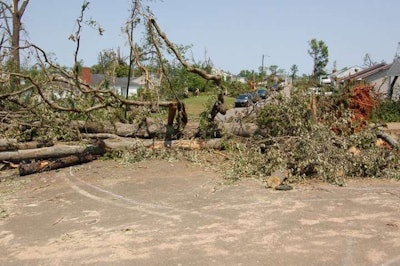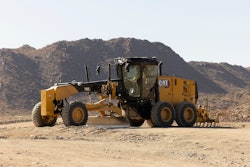
In the early chaos of a battle military leaders since Napoleon’s time have been taught to “ride to the sound of the guns.”
Tuscaloosa, Alabama, was every bit a battlefield starting about 4:30 p.m. on Wednesday, April 27, when an F5 tornado cut a 15 mile wide gash across the middle of this city of 100,000. Chaos reigned as the power and television transmissions went out, cell phone towers toppled and darkness fell over the rubble.
Attempts to get into the damaged areas that evening were turned back by the police. First responders, fire and rescue, had priority as they searched for bodies, and Alabama Power had to sort through a grid that had been scrambled like so much spaghetti across dozens of hilly neighborhoods studded thick with enormous oak, pine and sycamore trees, many of which had been shattered, uprooted and flung across homes, yards and roads.
But by dawn Thursday a spontaneous, self, organizing army of volunteers began to emerge and swarm into the hardest hit areas of Tuscaloosa. Local contractors, tree trimmers and heavy equipment operations moved in as well, but there was hardly enough of them to even begin to put a dent in the problem on day one.
I set out that morning with six guys from our church with chainsaws, plastic sheeting, and roofing supplies in a crew cab Ford F150. We spent the morning repairing damage and covering large sections of a church roof with plastic, but by lunch we were looking around wondering what to do next. We were ready and had the tools, but with most cell phones out of commission and the city yet to organize its brigades there was no one around to tell us what to do or where to go.
So our group, like thousands of others, did what you do in such circumstances—ride to the sound of the guns, or as a local policeman directing traffic told us—“just find something that needs doing and start doing it.”
That would prove to be the great operating principle of the next four days and not just for the volunteer chainsaw and construction crews, but for an army of helpers bringing food and cold bottled water to anyone who needed it. The police turned back gawkers and rubber-neckers, but if you had a truck and construction supplies or food or water or anything that could help, you were waved through.
Over the next three days people we’d never seen or asked brought us food or fed us at tent sites that sprung up like weeds near the battle zones. I don’t recall more than an hour passing when some stranger didn’t offer me a bottle of cold water. I was particularly impressed by the fact that these support volunteers had mastered a hub and spoke distribution system. Tall stacks of bottled water and bagged ice appeared under tailgate tents on the main thoroughfares. Volunteers on foot loaded up backpacks and boxes of food and water at the hubs and then fanned out into areas that were still blocked. Where the roads were passable, young people piled into the beds of pickups and drove through the affected areas handing out water to volunteers or dropping cases of water on the front steps of houses. On the main thoroughfares it seemed as if every third of fourth vehicle was a truck piled high with bottled water, many with out of state license plates. Water came in with LSU labels and Mississippi State labels (some of our arch rivals in football). All un-summoned, unannounced, unplanned and uncoordinated. Good citizens riding to the sound of the guns.
On Thursday afternoon we had just about cleared the first of a dozen or so big trees that had fallen across 26th street when a crew of volunteers from a Montgomery, Alabama tree service drove up and asked: “Mind if we help?”
Like so many others, they piled into a crew cab dually and headed into the action. With the addition of their three saws and five workers we got the street and six or eight driveways cleared in about three hours. This was in the one of the poorest sections of town but we never lacked for young men from the neighborhood who hauled the logs we cut to the curb so the men with the saws could cut uninterrupted.
The Montgomery crew followed us to our next site and helped clear out some trees from a local pastor’s yard. And the following morning they met us to take out a couple of massive oaks and several smaller trees that had fallen on a house in one of the richest neighborhoods in town.
By Saturday, professional crews were popping up in the more well to do neighborhoods, so we headed out to a low income area of town known as Alberta City, where some of the worst destruction occurred. There we found a blocked street and went to work. We might have been at that one street all day cutting a tangle of huge trees into manageable chunks, but a volunteer on a skid steer came scooting by, saw what we needed and pushed the larger sections of trunk to the curb in just seconds. Minutes later a tracked compact loader came by, on the prowl. It was like that everywhere we went: tractors, skid steers and tracked loaders racing around like diesel powered Pac-men, chomping through the rubble and debris.
As the next 48 hours progressed and roads and driveways were cleared the need for volunteer heavy construction and tree trimming abated. More and more professional crews showed up. The equipment got bigger and the police got more restrictive. The volunteer chainsaw and skid steer army began to diminish. But new army of repair and recovery volunteers is forming to tackle this next dimension of the challenge. And there is still plenty of chainsaw and skid steer work to be done in the rural areas of the state. This transition is part of the process in disaster response, according to ProPickup’s editor Bruce Smith, who lived through the Katrina experience on the Mississippi coast in 2005.
As a contractor looking for paying work or volunteer opportunities you need to understand how these cycles develop and learn where and when to get involved. So in future posting we’ll report more on how you as a professional contractor can get involved, what you need to have in place to qualify for bids and how to work safely and efficiently with disaster relief officials.







